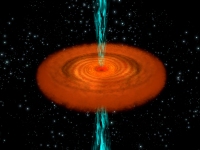X-ray observations of BAL Quasars with polar outflows
9 April 2008
X-ray observations with XMM-Newton of four polar broad absorption line quasars (BALQSOs) have been performed to ascertain whether strong X-ray attenuation, characteristic for BALQSOs, is also present in those seen face-on.BALQSOs constitute 10-20% of optically selected quasars and apart from the bright emission lines observed in all quasars show broad absorption lines (BAL) in the UV waveband. The absorption lines are blue shifted up to ~0.1 c, suggesting the absorbing material is moving towards us at high velocities. Another characteristic of BALQSOs is that they are highly attennuated in the soft X-rays, indicating there is a large amount of material that absorbs the X-ray emission from the inner regions of the accretion disk.
 |
|
Artist's impression of a quasar's jets, accretion disk and torus |
One of the key conditions to be explained by any BALQSO model is how the absorbing material responsible for the broad UV absorption lines is shielded from the quasar's central extreme UV and X-ray emission that would otherwise over-ionise the gas responsible for the UV absorption.
In a recent publication in the Astrophysical Journal Letters, JunXian Wang et al. present XMM-Newton observations of four BALQSOs. These were randomly selected from an earlier set of quasars that were determined to be seen face-on (see Zhou et al. 2006). The four BALQSO were identified from their UV spectra to contain the broad UV absorption features, and were determined to be seen face-on from their radio emission. The large amplitude of the variation in the radio suggests the radio emission is beamed towards us, meaning we are looking in the relativistic jet of material that is taken to be aligned with the polar axis perpendicular to the accretion disk.
Out of the four BALQSOs observed by XMM-Newton two were detected and for two an upper limit to the X-ray flux between 2-10 keV was determined. By comparing the ratio of optical emission to X-ray emission (and for the two non-detected sources the lower limit of this ratio) with the same ratio for X-ray normal quasars (non-BAL quasars without strong X-ray attenuation), it is found that the two detected BALQSOs have no X-ray attenuation. For the two non-detected the lower limit is derived and one of them only just falls outside the range of X-ray normal quasars, with the other one deviating in a more pronounced manner. The latter however might not be representative for the polar BALQSO class as it is thought to be intermediate between a quasar and another type of active galaxy, an ultra luminous infrared galaxy.
Different explanations for the observed combination of BAL in the UV but no attenuation of the soft X-ray emission are now being investigated further by JunXian Wang et al. to determine the X-ray nature of BALQSOs.
Related Publications
Wang, J. et al., "XMM-Newton Observations of Broad Absorption Line Quasars with Polar Outflows", ApJL., 676, L97-L100, 1 April 2008, DOI: 10.1086/586893
Zhou, H. et al., "Polar Outflows in Six Broad Absorption Line Quasars", ApJ., 639, 716-723 , 10 March 2006, DOI: 10.1086/499768
